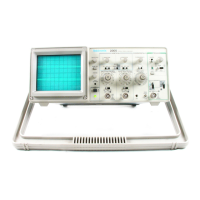Maintenance—2205 Service
CAUTION
When checking emitter-to-base junctions, do
not use an ohmmeter range that has a high
internal current. High current may damage
the transistor. Reverse biasing the emitter-
to-base junction with a high current may
degrade the current-transfer ratio (Beta) of
the transistor.
resistance between terminals with an ohmmeter set
to a range having a low internal source current, such
as the R X 1-kfl range. The diode resistance should
be very high in one direction and much lower when
the meter leads are reversed.
Silicon diodes should have 0.6 V to 0.8 V across
their junctions when conducting; Schottky diodes
about 0.2 V to 0.4 V. Higher readings indicate that
they are either reverse biased or defective, de
pending on polarity.
A transistor emitter-to-base junction also can be
checked for an open or shorted condition by
measuring the resistance between terminals with an
ohmmeter set to a range having a low internal
source current, such as the R X 1-kW range. The
junction resistance should be very high in one direc
tion and much lower when the meter leads are
reversed.. ■
When troubleshooting a field-effect transistor
(FET), the voltage across its elements can be
checked in the same manner as previously de
scribed for other transistors. However, remember
that in the normal depletion mode of operation, the
gate-to-source junction is reverse biased; in the en
hanced mode, the junction is forward biased.
INTEGRATED CIRCUITS. An integrated circuit
(1C) can be checked with a voltmeter, test oscil
loscope, or by direct substitution. A good
understanding of circuit operation is essential when
troubleshooting a circuit having 1C components. Use
care when checking voltages and waveforms around
the 1C so that adjacent leads are not shorted
together. An 1C test clip provides a convenient
means of clipping a test probe to an 1C.
When checking a diode, do not use en ohm-
meter scale that has a high internal current.
High current may damage a diode. Checks
on diodes can be performed in much the
same manner as those on transistor emitter-
to-base junctions.
DIODES. A diode can be checked for either an
open or a shorted condition by measuring the
RESISTORS. Check resistors with an ohmmeter.
Refer to the Replaceable Electrical Parts list for the
tolerances of resistors used in this instrument. A
resistor normally does not require replacement
unless its measured value varies widely from its
specified value and tolerance.
INDUCTORS. Check for open inductors by
checking continuity with an ohmmeter. Shorted or
partiafly shorted inductors can usually be found by
checking the waveform response when high-
frequency signals are passed through the circuit.
CAPACITORS. A leaky or shorted capacitor can
best be detected by checking resistance with an
ohmmeter set to one of the highest ranges. Do not
exceed the voltage rating of the capacitor. The
resistance reading should be high after the capacitor
is charged to the output voltage of the ohmmeter.
An open capacitor can be detected with a capaci
tance meter or by checking whether the capacitor
passes ac signals.
10. Repair and Adjust the Circuit
If any defective parts are located, follow the
replacement procedures given under Corrective
Maintenance in this section. After any electrical
component has been replaced, the performance of
that circuit and any other closely related circuit
should be checked. Since the power supplies affect
all circuits, performance of the entire instrument
should be checked if work has been done on the
power supplies or if the power transformer has been
replaced. Readjustment of the affected circuitry may
be necessary. Refer to the Performance Check Pro
cedure and Adjustment Procedure, Sections 4 and 5
of this manual and to Table 5-1 (Adjustments
Affected by Repairs).
6-9

